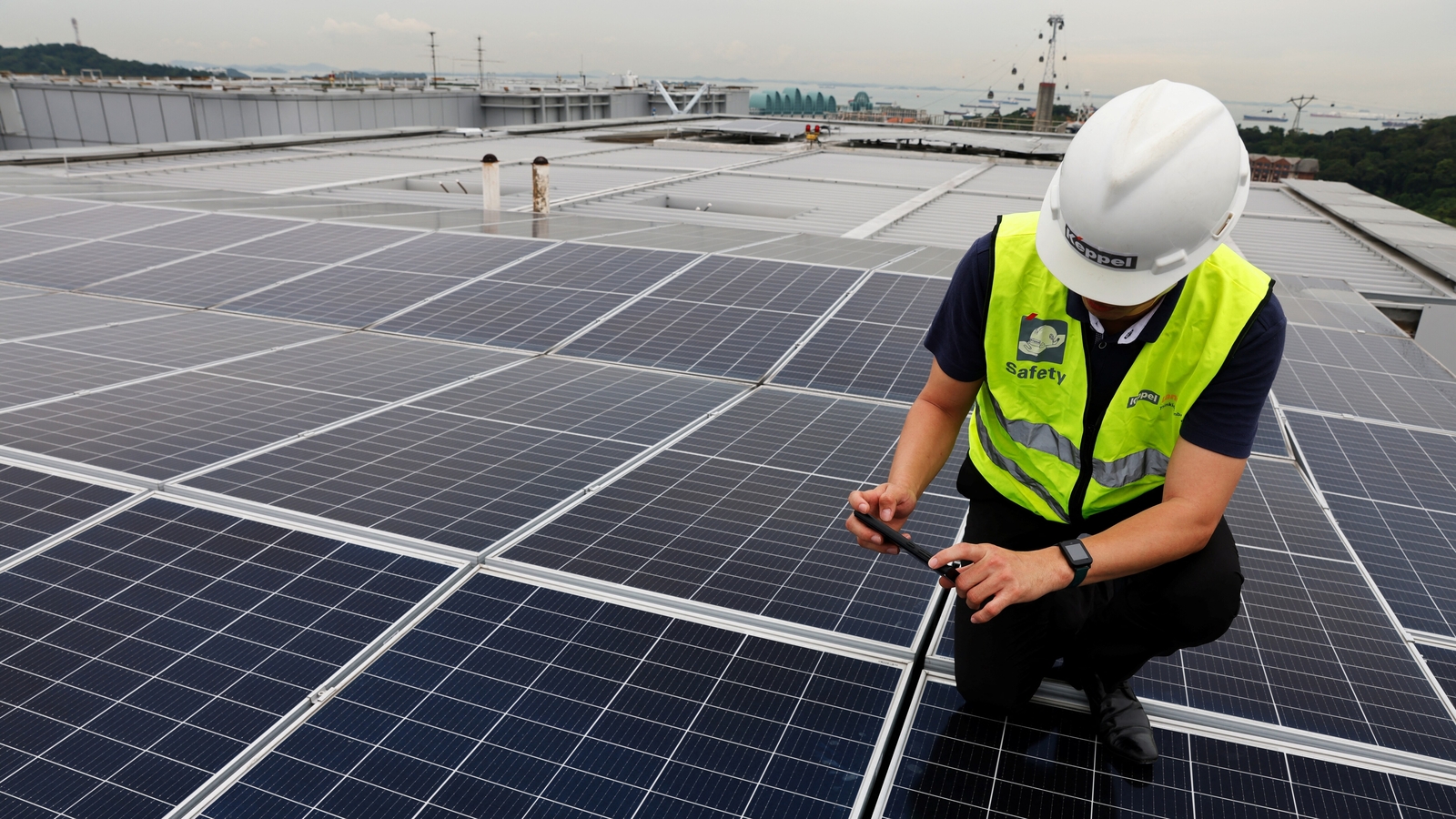Solar Power Boom Drives European Electricity Prices Negative

Table of Contents
The Explosive Growth of Solar Power in Europe
Europe is witnessing an unprecedented boom in solar energy installations. Driven by government subsidies, plummeting solar panel costs, and a growing awareness of the need for renewable energy, solar power capacity is expanding at an astonishing rate. This rapid increase in solar energy capacity is a key factor contributing to instances of negative European electricity prices.
- Leading Countries: Germany, Spain, Italy, and the Netherlands are among the European nations leading the charge in solar energy adoption, boasting significant increases in installed capacity over the past five years.
- Capacity Increase: Data shows a percentage increase in solar energy capacity exceeding 20% in many European countries over the last five years, demonstrating the rapid expansion of this renewable energy source.
- Supportive Policies: Government policies promoting renewable energy sources, such as feed-in tariffs and tax incentives, have played a crucial role in accelerating the growth of the European solar market. These policies significantly lower the cost of solar energy generation, making it more competitive against traditional energy sources.
The growth of solar power generation is fundamentally altering the landscape of European energy production, and the effects are being felt directly in the electricity market.
The Challenges of Integrating Solar Power into the Electricity Grid
The intermittency of solar power—its dependence on sunlight—presents significant challenges for grid stability. Periods of high solar generation, especially during peak sunlight hours, can lead to an oversupply of electricity, forcing prices into negative territory. This phenomenon, often visualized with the "duck curve," illustrates the mismatch between solar power generation and electricity demand.
- The Duck Curve: This illustrates the rapid increase in solar generation during the day, followed by a steep drop-off in the evening, requiring a significant ramp-up in conventional power plants to meet peak evening demand.
- Smart Grids: Smart grids, equipped with advanced technologies and data analytics, play a critical role in managing fluctuating energy supply from intermittent renewable sources like solar power, improving grid stability and efficiency.
- Energy Storage Solutions: The development and deployment of energy storage technologies, such as lithium-ion batteries, pumped hydro storage, and compressed air energy storage, are crucial for mitigating the intermittency of solar power and smoothing out supply fluctuations. These solutions allow the storage of excess solar power generated during peak sunlight hours and its release when demand is higher.
Addressing these integration challenges is vital to fully harness the potential of solar power and avoid the recurring issue of negative electricity prices.
The Economic Impact of Negative Electricity Prices
Negative European electricity prices have profound economic implications for both producers and consumers. While consumers might benefit from lower energy bills (in situations where they are equipped to take advantage of this), electricity producers, particularly those relying on fossil fuels or nuclear power, face significant challenges.
- Increased Consumption Incentives: Negative prices can incentivize increased electricity consumption, especially in energy-intensive industries, potentially leading to additional economic benefits.
- Arbitrage Opportunities: Sophisticated energy traders can exploit negative pricing through arbitrage, buying excess energy at a negative price and selling it at a positive price at a later time or in a different location.
- Stranded Assets: Conventional power plants (coal, gas, nuclear) face the risk of becoming "stranded assets" – power plants that are no longer economically viable due to the competition from cheaper renewable energy sources and the prevalence of negative pricing.
The fluctuating nature of electricity prices due to the influx of solar power creates both opportunities and risks within the broader energy market.
The Future of Solar Power and European Energy Markets
The solar power boom is reshaping Europe's energy landscape. The long-term implications are substantial, influencing energy policy, investment decisions, and the overall structure of the European energy market.
- Future Capacity Predictions: Experts predict a continued and possibly accelerated rise in solar power capacity in Europe over the coming decades, further influencing electricity prices and market dynamics.
- Policy Changes: Future European energy policies will need to adapt to effectively manage the integration of high levels of renewable energy, balancing the environmental benefits with economic stability and grid reliability.
- Emerging Technologies: Emerging technologies, such as advanced energy storage and smart grid management systems, will play a critical role in mitigating the challenges associated with high renewable energy penetration, improving grid stability and facilitating the efficient use of solar energy.
The future of the European energy market is intrinsically linked to the continued expansion of solar power and its successful integration into the energy infrastructure.
Conclusion: The Impact of Solar Power on European Electricity Prices
The rapid expansion of solar power is significantly impacting European electricity markets, frequently leading to periods of negative pricing. This transition to a renewable-energy-dominated system presents both considerable challenges and exciting opportunities. Addressing the intermittency of solar power through smart grid technologies, advanced energy storage solutions, and supportive policy frameworks is critical to ensuring a stable and reliable energy supply while fully realizing the benefits of solar energy. The future of energy in Europe hinges on navigating these challenges effectively. Learn more about how the rise of solar power is shaping European energy markets and explore the potential of investing in renewable energy solutions. Understanding the interplay between solar power and European electricity prices is crucial for shaping a sustainable and economically viable energy future.

Featured Posts
-
 Nyt Spelling Bee February 12 2025 Clues Answers And Pangram
Apr 29, 2025
Nyt Spelling Bee February 12 2025 Clues Answers And Pangram
Apr 29, 2025 -
 Nyt Strands April 29th Game 422 Answers And Helpful Hints
Apr 29, 2025
Nyt Strands April 29th Game 422 Answers And Helpful Hints
Apr 29, 2025 -
 Nyt Strands Answers March 3 2025 Guidance And Solutions
Apr 29, 2025
Nyt Strands Answers March 3 2025 Guidance And Solutions
Apr 29, 2025 -
 Hungary Defies Us Pressure Maintaining Strong Economic Ties With China
Apr 29, 2025
Hungary Defies Us Pressure Maintaining Strong Economic Ties With China
Apr 29, 2025 -
 February 25 2025 Nyt Spelling Bee Clues And Complete Solutions
Apr 29, 2025
February 25 2025 Nyt Spelling Bee Clues And Complete Solutions
Apr 29, 2025
Latest Posts
-
 Remembering The Fallen Fort Belvoir Honors Soldiers Killed In Dc Helicopter Crash
Apr 29, 2025
Remembering The Fallen Fort Belvoir Honors Soldiers Killed In Dc Helicopter Crash
Apr 29, 2025 -
 Investigation Reveals Pilots Actions Before Deadly Black Hawk Crash In Washington D C
Apr 29, 2025
Investigation Reveals Pilots Actions Before Deadly Black Hawk Crash In Washington D C
Apr 29, 2025 -
 Dc Black Hawk Crash New Report Reveals Pilot Error Before Collision
Apr 29, 2025
Dc Black Hawk Crash New Report Reveals Pilot Error Before Collision
Apr 29, 2025 -
 Black Hawk Collision Near Dc Report Details Pilots Failure To Follow Instructions
Apr 29, 2025
Black Hawk Collision Near Dc Report Details Pilots Failure To Follow Instructions
Apr 29, 2025 -
 The Ny Times And The January 29th Dc Air Disaster What Was Omitted
Apr 29, 2025
The Ny Times And The January 29th Dc Air Disaster What Was Omitted
Apr 29, 2025
